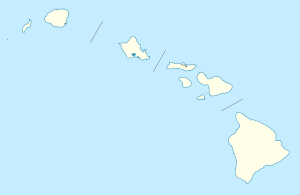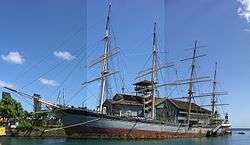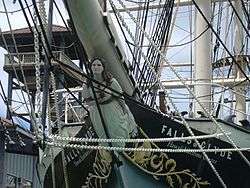Falls of Clyde (ship)
 Falls of Clyde at Honolulu Harbor | |
| History | |
|---|---|
| Name: | Falls of Clyde |
| Builder: | Russell and Company in Port Glasgow, Inverclyde, Scotland |
| Launched: | 1878 |
| Homeport: | Honolulu, Hawaii |
| Status: | Museum ship |
| General characteristics | |
| Type: | Windjammer |
| Tonnage: | 1807 gross; 1741 net |
| Masts: | 4 |
| Configuration: | Fully rigged ship |
| Figurehead: | Maiden |
| Length: | 280 ft (85.3 m) |
| Beam: | 40 ft (12.2 m) |
| Draft: | 21 ft (6.4 m) |
|
Falls of Clyde (Four-masted Oil Tanker) | |
 | |
| Location | Pier 7, Honolulu Harbor, Honolulu, Hawaii |
| Coordinates | 21°18′20.5″N 157°51′54″W / 21.305694°N 157.86500°WCoordinates: 21°18′20.5″N 157°51′54″W / 21.305694°N 157.86500°W |
| Built | 1888 |
| Architect | William Lithgow |
| NRHP Reference # | 73000659[1] |
| Added to NRHP | 1973 |
Falls of Clyde is the last surviving iron-hulled, four-masted full-rigged ship, and the only remaining sail-driven oil tanker. Designated a U.S. National Historic Landmark in 1989, she is now a museum ship in Honolulu, but her condition has deteriorated. She is currently not open to the public. In September 2008, ownership was transferred to a new nonprofit organization, the Friends of Falls of Clyde, which intends to restore her. Efforts to raise $1.5 million to get the ship into drydock have not succeeded as of 2015. An additional $30 million may be needed to fully restore the ship.
In August, 2016, the Harbors Division of the State of Hawaii impounded the ship. Efforts are underway to convince the Governor to preserve the ship, including an online petition.
History
Falls of Clyde was built in 1878 by Russell and Company in Port Glasgow, Inverclyde, Scotland, launched as the first of nine iron-hulled four-masted ships for Wright and Breakenridge's Falls Line.[2] She was named after the Falls of Clyde, a group of waterfalls on the River Clyde, and built to the highest standard for general worldwide trade, Lloyd's Register A-1. Her maiden voyage took her to Karachi, now in Pakistan, and her first six years were spent engaged in the India trade. She then became a tramp pursuing general cargo such as lumber, jute, cement, and wheat from ports in Australia, California, India, New Zealand, and the British Isles.
After twenty-one years as a British merchantmen, Falls of Clyde was purchased for US$25,000 by Captain William Matson of the Matson Navigation Company, taken to Honolulu in 1899, and registered under the Hawaiian flag. When the Republic of Hawaii was annexed by the United States in 1900, it took a special act of the United States Congress to secure the foreign-built ship the right to sail as an American flag vessel.
To economize on crew, Matson rigged Falls of Clyde down as a barque, replacing the five yards on her (jigger) mast with two more easily managed fore-and-aft sails. At the same time, he added a deckhouse, charthouse, and rearranged the after quarters to accommodate paying passengers. From 1899 to 1907, she made over sixty voyages between Hilo, Hawaii, and San Francisco, California, carrying general merchandise west, sugar east, and passengers both ways. She developed a reputation as a handy, fast, and commodious vessel, averaging 17 days each way on her voyages.
In 1907, the Associated Oil Company (later Tidewater Oil) bought Falls of Clyde and converted her to a bulk oil tanker with a capacity of 19,000 barrels (3,000 m3). Ten large steel tanks were built into her hull, and a pump room, boiler and generator fitted forward of an oil-tight bulkhead.[2] In this configuration she brought kerosene to Hawaii and returned to California with molasses for cattle feed.

In 1927, she was sold to the General Petroleum Company, her masts cut down, and converted into a floating fuel depot in Alaska. In 1959 she was purchased by William Mitchell, who towed her to Seattle, Washington, intending to sell her to a preservation group. Mitchell's plan fell through and subsequent efforts by Karl Kortum, director of the San Francisco Maritime Museum, and Fred Klebingat, who had sailed in her as chief mate in 1915, to place her in Long Beach, California, or Los Angeles, California, were similarly disappointed.
In 1963, the bank holding the mortgage on Falls of Clyde decided to sell her to be sunk as part of a breakwater at Vancouver, British Columbia. Kortum and Klebingat aroused interest in the ship in Hawaii, and within days of the scheduled scuttling raised funds to buy the ship. At the end of October 1963, Falls of Clyde was taken under tow bound for Honolulu.
Museum ship and controversy


Falls of Clyde was given to the Bishop Museum and opened to the public in 1968. In 1970 the grandson of original 19th century designer William Lithgow was engaged to assist in her restoration as a full-rigged ship. Support came from Sir William Lithgow, the shipbuilder and industrialist, whose Port Glasgow shipyard donated new steel masts, and topgallants, jib and spanker booms of Oregon pine.[2]
In 1973 the ship was entered into the National Register of Historic Places,[3] and declared a U.S. National Historic Landmark in 1989.[3][4]
The ship is now in poor condition. Causes of the deterioration of the ship are multiple. The ship has not been dry docked for a long time. Sandblasting arguably damaged the ship. Preventive maintenance was not performed, although it would have been relatively inexpensive. In fact, her long-time owner, the Bishop Museum, "has been accused of incompetence and dishonesty" for raising $600,000 to preserve the ship but then spending only about half that, and for other decisions on how the money that was spent.[5][6]
In 2008, the Bishop Museum announced plans to sink her by the end of the year unless private funds were raised for an endowment for her perpetual care.[7] In September 2008 the Bishop Museum was persuaded to transfer ownership to the non-profit group Friends of Falls of Clyde, which intends to restore her. However, many artifacts and fixtures had been given away, taken, or otherwise disappeared on the assumption that the ship was to be scuttled.[8][9] $350,000 was obtained from the Robert J. Pfeiffer Foundation, but hoped-for federal funds under the "Save America's Treasures" program or other programs did not come through.[10] In each year since 2008,[11] the Foundation has hoped to get her into drydock but has not succeeded as of 2015.[12] In June 2016 Harbors Division of the Hawaii Department of Transportation revoked the permit for her to moor at Pier 7, citing safety and security risks to port users.[13] The Foundation has challenged the Harbors Division's assessment of the ship.
In August 2016 a group based in Glasgow, Scotland launched the Save Falls of Clyde - International Campaign, with a view to have her returned to Scotland where she was originally built. The campaign is being run in conjunction with the former Glasgow Nautical College as well as Fairtransport a Dutch Fair Trade sailing ship company.
The group hopes to have the ship rebuilt as required and put back to sea as a community based sail training ship, working to earn her living also as a fair trade transport ship, the biggest of her type that would currently be available. It is hoped to have her repaired by the current Ferguson Marine of Port Glasgow, the successor shipyard to A.E.Russel's where she was built in 1878.
If however she is not able to be restored to sailing condition then she will become part of a Clyde Heritage centre on the River Clyde possibly sitting beside the S.V. Glenlee also built at the same yard.
All offers of help should be made through our facebook page Save Falls of Clyde - International
Uses in popular culture
- The ship appears as a filming location in Magnum, P.I., Season 2, Episodes 5 and 6, "Memories are Forever" (November 5, 1981)[14] and Season 6, Episode 10, "Blood and Honor" (November 21, 1985).[15]
References
- ↑ National Park Service (2010-07-09). "National Register Information System". National Register of Historic Places. National Park Service.
- 1 2 3 Carter, Robert (September 2008). "Notes on a Picture: Falls of Clyde". Australian Sea Heritage. Sydney, Australia: Sydney Maritime Museum Ltd (93/94): 59–61.
- 1 2 "Falls of Clyde (Sailing Oil Tanker)". National Historic Landmark summary listing. National Park Service. Retrieved 2008-06-20.
- ↑ Delgado, James P. (15 July 1988). "National Historic Landmark Nomination: Falls of Clyde" (pdf). National Park Service. Retrieved 2009-06-22. and
"Accompanying photos, exterior and interior, from 1986, 1988 and undated" (pdf). Retrieved 2012-08-31. - ↑ Pala, Christopher (18 October 2008). "Historic Ship Stays Afloat, for Now". The New York Times. Retrieved 2008-10-19.
- ↑ Pala, Christopher (24 September 2008). "Title unknown". Honolulu Weekly.
- ↑ Hall, Sabrina (22 February 2008). "Falls of Clyde May Have Sinking Fate". KGMB9 News Hawaii. Archived from the original on 2009-01-09. Retrieved 2013-03-02.
- ↑ Bernardo, Rosemarie (27 September 2008). "Museum to transfer historic ship". Honolulu Star-Bulletin. Retrieved 2013-03-02.
- ↑ Mary Vorsino (December 1, 2008). "Falls of Clyde artifacts missing". Honolulu Advertiser. Retrieved March 7, 2015.
- ↑ Catherine Cruz (July 3, 2012). "Steel-hulled sailing tanker Falls of Clyde faces funding challenges". KITV.com. Retrieved March 7, 2015.
- ↑ "Historic 'Falls of Clyde' has sights set on dry dock". Hawaii News Noew. July 22, 2012. Retrieved March 7, 2015.
- ↑ Evelyn Hunter (August 11, 2014). "Drydock". The Friends of Falls of Clyde website. Retrieved March 7, 2015.
- ↑ "State 'evicts' Falls of Clyde from Honolulu Harbor, citing safety concerns". khon2. LIN Television corp. 16 June 2016. Retrieved 18 June 2016.
- ↑ "Memories are Forever (2)". Magnum-Mania.com. Retrieved 26 March 2015.
- ↑ "Blood and Honor". Magnum-Mania.com. Retrieved 26 March 2015.
- Jim Gibb, Pacific Square-Riggers (Schiffer Publishing, 1987) ISBN 0-88740-106-6 p. 110
- Heine, Historic Ships of the World
- Klebingat, "Falls of Clyde"
External links
| Wikimedia Commons has media related to Falls of Clyde. |
- Hawai`i Maritime Center
- Maritime Heritage Program Information for the Falls of Clyde
- Princess Bernice Pauahi Bishop Museum
- Falls of Clyde on HawaiiWeb
- Friends of Falls of Clyde website
- Historic American Engineering Record (HAER) No. HI-7, "Ship "Falls of Clyde", Hawaii Maritime Center,Pier 7, Honolulu, Honolulu County, HI", 23 photos, 2 color transparencies, 15 measured drawings, 3 data pages, 4 photo caption pages